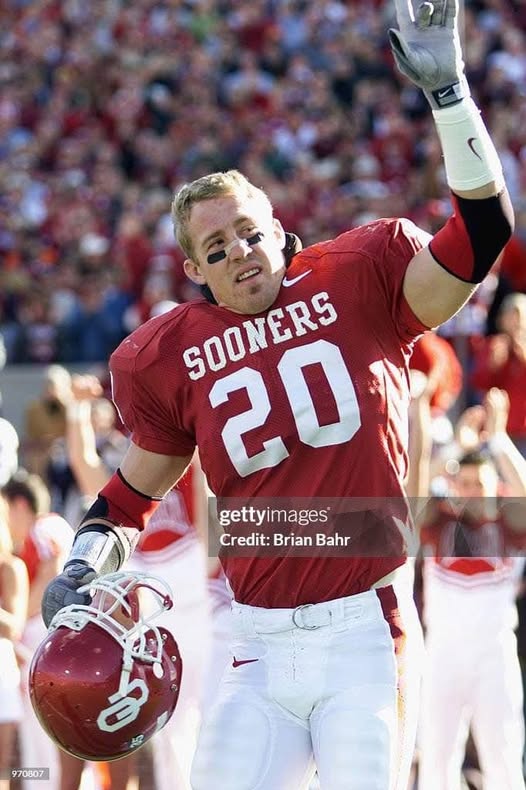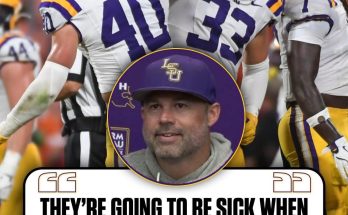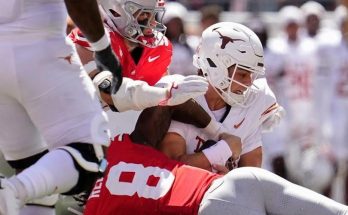Rocky Calmus’s long-awaited induction into the 2025 College Football Hall of Fame represents the culmination of a storied career defined by dominance, determination, and dedication. At the intersection of individual excellence and team success, Calmus etched his name into college football lore at the University of Oklahoma before overcoming professional setbacks to ultimately receive this prestigious honor. His journey speaks to the resilience of a champion whose impact was felt both on and off the field—and now, more than two decades after leaving Norman, he’s been invited into the sport’s hallowed sanctuary.
Calmus emerged from Jenks High School in Tulsa, Oklahoma, a powerhouse program known for its sustained excellence. He arrived in Norman in 1998, joining a Sooners team undergoing a renaissance under first coach John Blake and, soon after, Bob Stoops. Over the next four years, Calmus would become the heart of a revitalized defense and one of the most decorated linebackers in NCAA history. His talents were clear early on, but what defined his college tenure was how he maximized every opportunity—even amid mounting expectations.
From 1999 onward, Calmus’s presence at linebacker was undeniable. As a sophomore, he recorded 114 tackles and 14 tackles for loss, earning first-team All-Big 12 honors and helping Oklahoma reach its first bowl game since 1994. The following year, he exploded for 125 tackles and 17 TFLs, earning AP Big 12 Defensive Player of the Year and consensus first-team All-America honors. Crucially, those performances helped propel the Sooners to a perfect 13–0 record and a national championship victory in the Orange Bowl, capping an unforgettable season X (formerly Twitter)+4Facebook+4Yahoo Sports+4WikipediaUniversity of Oklahoma.
Calmus’s senior season in 2001 cemented his legacy. Anchoring a defense that became the backbone of a consistently elite team, he led Oklahoma with 117 tackles and 15 TFLs. He became the first Sooner to win the Butkus Award as the nation’s top linebacker and was also a finalist for the Nagurski, Bednarik, and Lombardi Awards. In doing so, he collected consensus All-America honors for a second consecutive year University of Oklahoma. By the conclusion of his collegiate career, he had amassed an astounding 431 tackles (fourth in school history), 59 career tackles for loss (a program record), 14 sacks by an inside linebacker, 26 pass breakups (double the next closest), seven fumble recoveries, two pick-sixes, five forced fumbles, and three blocked kicks—all across 44 consecutive starts University of Oklahoma. Simply put, his numbers were overwhelming in both scope and impact.
Despite this extraordinary profile, Calmus’s journey to the Hall had to begin with a ballot nomination—and predictably, it arrived. In June 2024, the National Football Foundation revealed he, along with fellow Sooners George Cumby and Josh Heupel, among 77 FBS players, had earned a spot on the 2025 ballot National Football Foundation+6University of Oklahoma+6News 9+6. The writing was on the wall: they were college legends being considered for permanent enshrinement. The selection process is notoriously competitive—of the more than 5.7 million men who have played college football, only about 1,500 have ever appeared on a Hall ballot University of Oklahoma—and balloting is governed by thousands of NFF members, current Hall inductees, and an esteemed Honors Court chaired by Archie Griffin University of Oklahoma+1National Football Foundation+1.
To be among that initial list is, in itself, a testament to Calmus’s impact. But to actually earn induction means he had to earn votes—a reflection not only of his statistical domination, but also of the lasting impressions he left on teammates, opponents, coaches, and media voters alike. As April 2025 turned into May, excitement and speculation in Oklahoma grew. Sooners nation—long accustomed to celebrating its defensive prowess—anxiously awaited confirmation that one of its brightest defensive stars would at last be immortalized.
That confirmation came when the 2025 inductees were officially announced: Rocky Calmus was in. The late spring and early summer brought celebration from Norman to Tulsa. University of Oklahoma Chancellor David Boren praised the linebacker’s work ethic and character, noting he embodied the spirit of Sooner football and served as a cultural anchor in Bob Stoops’s program rebirth. Teammates shared stories of Calmus’s relentless training habits, film room dedication, and mentorship of younger players. For them, his induction was more than owed—it was necessary.
Across sports media, attention turned to the broader significance of Calmus’s enshrinement. Pundits pointed to his record-setting metrics—still standing nearly a quarter-century later—as proof of his influence on defensive linebacker play. He helped redefine expectations for tackles for loss, quarterback pressures, and versatile coverage duties from the linebacker position. Inducting him, they said, was both historic and overdue.
Calmus’s journey after college propelled him to the NFL, where he was drafted by the Tennessee Titans in 2002. Though injuries curtailed a promising pro career—ultimately leading to retirement after brief stints with the Titans and Colts—he parlayed his discipline into success outside the game. In Tennessee, he launched a landscaping business, demonstrating the same work ethic and leadership that had powered his college dominance X (formerly Twitter)+6Wikipedia+6atozsports.com+6.
Now, over two decades later, that decade in Norman is receiving its due recognition. The Hall’s induction ceremony will take place in December 2025 during the National Football Foundation’s Annual Awards Dinner in Las Vegas. Before then, however, Calmus will participate in an NFF Hall of Fame On-Campus Salute during the Sooners’ upcoming season. That moment will bring thousands of fans face to face with the player they cheered on—and with the coach who inherited his leadership mantle.
There is a sense of rightful redemption in this honor. Calmus’s record and accolades were indisputable from the day he graduated. Yet Hall of Fame recognition often arrives with delay—owing to the intense scrutiny and narrowness of Hall selections. Calmus waited his turn. His persistence reflected the same traits that had propelled him to the field’s top: consistency, grit, and excellence. Today, with induction confirmed, he gains not just a place in the Hall of Fame building in Atlanta, but a permanent place in the conversation of the game’s all‑time defensive greats.
That conversation extends beyond record books. It echoes in the modern Sooner locker room, where current linebackers study his film. It resonates in scouting rooms, where evaluators still cite Calmus’s 2000–2001 stretch as a positional standard. It influences recruiting pitches, where Oklahoma pitches its defensive pedigree by name. That legacy is alive—and it’s alive because of Calmus.
At 45 years old, with a life firmly rooted off the field, the spotlight on Calmus now takes on new meaning. It transcends his playing days. His story becomes emblematic of football’s enduring values: teamwork, perseverance, and purpose. In the Hall of Fame speech he’s sure to deliver, expect gratitude—for coaches, teammates, family—and perhaps a reflection on the time that sandwiched his collegiate years and this moment of recognition.
Calmus’s induction also shines a light on the broader realm of college football honors. The Hall’s requirement—that inductees be former first‑team All-Americans—eliminates all but elite few, leaving fewer than 1,500 candidates out of millions. That selection of 77 players per year is already minuscule, ultimately narrowing to a dozen or fewer inductees each season University of Oklahoma+1National Football Foundation+1. In that context, Calmus’s inclusion is a validation not simply of retrospective admiration, but of sustained, enduring excellence.
And for Oklahoma fans, it’s cause for collective pride. The Sooners already boast an impressive Hall tally—but Calmus adds to that legacy with an authenticity rooted in both individual skill and team success. He represents a golden era of Sooners defense and the resurgence under Stoops—an era built on toughness, discipline, and elite coaching.
As 2025 unfolds, Calmus’s impending induction invites celebration across campus, alumni networks, and within communities connected by pride in Sooner heritage. Oklahoma will host its own tribute game-day gesture. Players will don No. 54 decals. Former teammates will return. His children, if he has them, will stand beside him. They will witness their father proclaimed as one of college football’s best—a hero, now immortalized.
It’s the kind of moment that rewrites the narrative on a life well led. Rocky Calmus’s induction isn’t just recognition of defensive numbers; it is recognition of how one person can shape games, galvanize fans, and define a program. And it suggests a broader theme: that greatness may be measured in tackles and stats, but it is honored in storytelling, remembrance, and legacy.
The 2025 College Football Hall of Fame class may yet grow—other Sooners and peers of Calmus might follow—but his place is now secure. History will list his achievements. Visitors to the Hall in Atlanta will encounter his name. Recruiting materials will bear his image. Decades from now, when linebackers don the Sooners’ red and cream, they’ll look back at film reels of No. 54 and be inspired.
Rocky Calmus’s story reminds us that greatness is patient. Sometimes, recognition comes long after the final whistle. But when it arrives, it lands with impact. The College Football Hall of Fame’s induction of Calmus in 2025 is not merely a capstone to a distinguished career—it is the fitting tribute to a linebacker whose influence, both in tackles and character, transcended his era and etched him permanently into the annals of the game.



